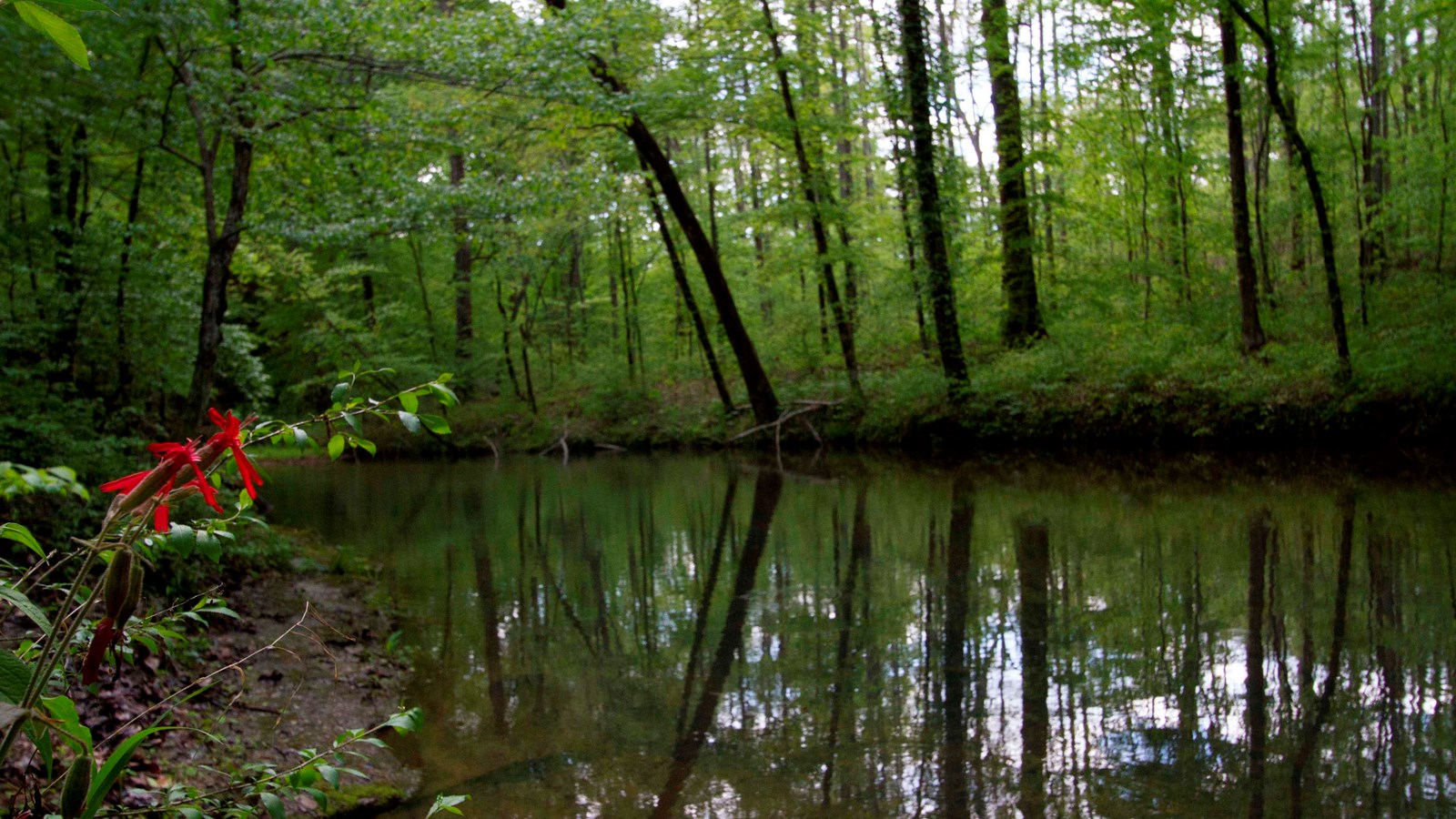Last updated: September 15, 2022
Place
Sweetwater Branch, Milepost 363.0

NPS Photo/ Kristen Maxfield
Quick Facts
Location:
Milepost 363 on the Natchez Trace Parkway
Significance:
Nature Trail
Amenities
1 listed
Trailhead
Sweetwater Branch is a place where you can connect with nature. The trail is 2500 feet up and back.
The terrain along the northern Parkway differs from that further south. Here, the land is rocky. Erosion is at work. The combined efforts of the stream, rain, and plants form a powerful force. Bedrock is being reduced to boulders, and boulders to stone, gravel, and sand. The eroded bedrock is then washed downstream.In the flatlands along most of the Parkway, sediments carried downstream settle out and come to rest, forming a soft, silty bottom. But a glance at the rocky streambed of Sweetwater Branch provides a vivid lesson in erosive power and undercuts the notion of “solid rock.”
What to look for:
Where Rock and Water Meet
The interplay of rock and water shapes the landscape around you. Close your eyes. Listen. Sniff the air. Even without seeing, you can tell this place differs from others along the Parkway. The difference is rock – exposed beds of limestone and sandstone that effect how the forest looks, sounds, even smells. In the flatlands further south, you do not hear the rush and splash of a cascading stream that breaks down the rock. The rushing creek rounds off edges, tumbles boulders downstream, erodes them down to stone, gravel, sand-grain sized, and eventually to soil. While areas to the south have been shaped by deposited material, this area is being shaped by erosion.
Silent Stonemasons
Working their way into cracks and crevices, roots help break down the rocky terrain. A plant can be an irresistible force. Roots from trees or walking ferns probe into cracks or fractures in the rock. In time as they grow, they wedge rocks apart or cause pieces to break off. Aided by the repeated freezing and thawing of water, the slow, silent, relentless power of growth can reduce rock to rubble.
Rock Today, Soil Tomorrow
Rock breaks down into soil, and the kind of soil it forms affects what grows. Soil consists of tiny particles of rock mixed with decaying matter from plants and animals. Different kinds of rock form different kinds of soil.The soil found here results largely from the breakdown of limestone, which has alkaline properties, like baking soda. Alkaline soil reacts chemically with acid from rain and neutralizes it. Hardwood trees (rather than pines) favor this kind of soil, so the rock helps determine what kinds of plants grow here.
The terrain along the northern Parkway differs from that further south. Here, the land is rocky. Erosion is at work. The combined efforts of the stream, rain, and plants form a powerful force. Bedrock is being reduced to boulders, and boulders to stone, gravel, and sand. The eroded bedrock is then washed downstream.In the flatlands along most of the Parkway, sediments carried downstream settle out and come to rest, forming a soft, silty bottom. But a glance at the rocky streambed of Sweetwater Branch provides a vivid lesson in erosive power and undercuts the notion of “solid rock.”
What to look for:
- Interactions between plants, water, and rock
- Plants breaking down rocks
- The effects of erosion by water
- Running water gradually wears away small particles of rock, shrinking and smoothing the larger rock left behind.
- Rock being reduced to progressively smaller particle sizes
- When combined with organic matter, the smallest rock eventually become soil.
Where Rock and Water Meet
The interplay of rock and water shapes the landscape around you. Close your eyes. Listen. Sniff the air. Even without seeing, you can tell this place differs from others along the Parkway. The difference is rock – exposed beds of limestone and sandstone that effect how the forest looks, sounds, even smells. In the flatlands further south, you do not hear the rush and splash of a cascading stream that breaks down the rock. The rushing creek rounds off edges, tumbles boulders downstream, erodes them down to stone, gravel, sand-grain sized, and eventually to soil. While areas to the south have been shaped by deposited material, this area is being shaped by erosion.
Silent Stonemasons
Working their way into cracks and crevices, roots help break down the rocky terrain. A plant can be an irresistible force. Roots from trees or walking ferns probe into cracks or fractures in the rock. In time as they grow, they wedge rocks apart or cause pieces to break off. Aided by the repeated freezing and thawing of water, the slow, silent, relentless power of growth can reduce rock to rubble.
Rock Today, Soil Tomorrow
Rock breaks down into soil, and the kind of soil it forms affects what grows. Soil consists of tiny particles of rock mixed with decaying matter from plants and animals. Different kinds of rock form different kinds of soil.The soil found here results largely from the breakdown of limestone, which has alkaline properties, like baking soda. Alkaline soil reacts chemically with acid from rain and neutralizes it. Hardwood trees (rather than pines) favor this kind of soil, so the rock helps determine what kinds of plants grow here.
